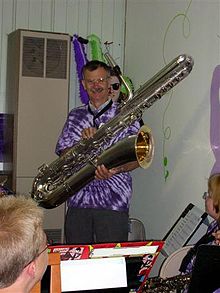Bass saxophone

A 1920s Conn bass saxophone
|
|
| Woodwind instrument | |
|---|---|
| Classification | |
| Hornbostel–Sachs classification | 422.212-71 (Single-reeded aerophone with keys) |
| Inventor(s) | Adolphe Sax |
| Developed | 28 June 1846 |
| Playing range | |
|
In B♭: sounds two octaves and a major second lower than written |
|
| Related instruments | |
|
Military band family:
Orchestral family: Other saxophones:
|
|
| Musicians | |
| More articles | |
Military band family:
Orchestral family:
Other saxophones:
The bass saxophone is one of the largest members of the saxophone family—larger than the more commonly encountered baritone saxophone. It was the first type of saxophone presented to the public, when Adolphe Sax presented a bass saxophone in C at an exhibition in Brussels in 1841. The modern bass saxophone is a transposing instrument pitched in B♭, an octave below the tenor saxophone. The bass saxophone is not commonly used in any music, but it is heard on some 1920s jazz recordings; in free jazz; and in the saxophone choir or "large ensemble" tradition.
The instrument was first used in 1844, both by Hector Berlioz in an arrangement of his Chant sacred, and by Georges Kastner in his opera Le Dernier Roi de Judas. In the 1950s and 1960s it enjoyed a brief vogue in orchestrations for musical theater: Leonard Bernstein’s original score for West Side Story includes bass saxophone, as does Meredith Willson’s Music Man and Sandy Wilson’s The Boy Friend. American composer Warren Benson has championed the use of the instrument in his music for concert band.
Although bass saxophones in C were made for orchestral use, modern instruments are in B♭. This puts them a perfect fourth lower than the baritone sax and an octave lower than the tenor sax. The range is similar to that of the B♭ contrabass clarinet. Music is written in treble clef, just as for the other saxophones, with the pitches sounding two octaves and a major second lower than written. As with most other members of the saxophone family, the lowest written note is the B♭ below the staff—sounding as a concert A♭ in the first octave (~ 51.9 Hz).
...
Wikipedia

